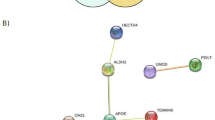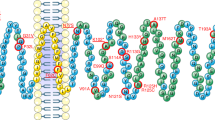Abstract
We have identified a variant in ADCY3 (encoding adenylate cyclase 3) associated with markedly increased risk of obesity and type 2 diabetes in the Greenlandic population. The variant disrupts a splice acceptor site, and carriers have decreased ADCY3 RNA expression. Additionally, we observe an enrichment of rare ADCY3 loss-of-function variants among individuals with type 2 diabetes in trans-ancestry cohorts. These findings provide new information on disease etiology relevant for future treatment strategies.
This is a preview of subscription content, access via your institution
Access options
Access Nature and 54 other Nature Portfolio journals
Get Nature+, our best-value online-access subscription
$29.99 / 30 days
cancel any time
Subscribe to this journal
Receive 12 print issues and online access
$209.00 per year
only $17.42 per issue
Buy this article
- Purchase on Springer Link
- Instant access to full article PDF
Prices may be subject to local taxes which are calculated during checkout

Similar content being viewed by others
References
Moltke, I. et al. Nature 512, 190–193 (2014).
Pedersen, C. T. et al. Genetics 205, 787–801 (2017).
Speliotes, E. K. et al. Nat. Genet. 42, 937–948 (2010).
Warrington, N. M. et al. Int. J. Epidemiol. 44, 700–712 (2015).
Lek, M. et al. Nature 536, 285–291 (2016).
Fuchsberger, C. et al. Nature 536, 41–47 (2016).
Sigma Type Diabetes Consortium. J. Am. Med. Assoc. 311, 2305–2314 (2014).
Lohmueller, K. E. et al. Am. J. Hum. Genet. 93, 1072–1086 (2013).
Laakso, M. et al. J. Lipid Res. 58, 481–493 (2017).
Panoutsopoulou, K. et al. Nat. Commun. 5, 5345 (2014).
Liu, Y. et al. PLoS One 8, e66883 (2013).
Vitting-Seerup, K. & Sandelin, A. Mol. Cancer Res. 15, 1206–1220 (2017).
Xu, T. R., Yang, Y., Ward, R., Gao, L. & Liu, Y. Cell. Signal. 25, 2413–2423 (2013).
Yang, H. & Yang, L. J. Mol. Endocrinol. 57, R93–R108 (2016).
Tong, T., Shen, Y., Lee, H. W., Yu, R. & Park, T. Sci. Rep. 6, 34179 (2016).
Pitman, J. L. et al. PLoS One 9, e110226 (2014).
Wang, Z. et al. PLoS One 4, e6979 (2009).
Chen, X. et al. Biol. Psychiatry 80, 836–848 (2016).
Vaisse, C., Reiter, J. F. & Berbari, N. F. Cold Spring Harb. Perspect. Biol. 9, a028217 (2017).
Dupuis, J. et al. Nat. Genet. 42, 105–116 (2010).
Tachmazidou, I. et al. Am. J. Hum. Genet. 100, 865–884 (2017).
Bjerregaard, P. et al. Int. J. Circumpolar Health 62 (Suppl. 1), 3–79 (2003).
Bjerregaard, P. Inuit Health in Transition—Greenland Survey 2005–2010 2nd edn (National Institute of Public Health, Copenhagen, 2011).
Philipsen, A. et al. PLoS One 10, e0123062 (2015).
Jørgensen, M. E., Borch-Johnsen, K., Stolk, R. & Bjerregaard, P. Diabetes Care 36, 2988–2994 (2013).
Matthews, D. R. et al. Diabetologia 28, 412–419 (1985).
Gutt, M. et al. Diabetes Res. Clin. Pract. 47, 177–184 (2000).
World Health Organization Study Group. Definition, Diagnosis and Classification of Diabetes Mellitus and its Complications (World Health Organization, Geneva, 1999).
Andersen, M. K. et al. PLoS Genet. 12, e1006119 (2016).
Zhou, X. & Stephens, M. Nat. Genet. 44, 821–824 (2012).
Alexander, D. H., Novembre, J. & Lange, K. Genome Res. 19, 1655–1664 (2009).
Moltke, I. & Albrechtsen, A. Bioinformatics 30, 1027–1028 (2014).
Bolger, A. M., Lohse, M. & Usadel, B. Bioinformatics 30, 2114–2120 (2014).
Kim, D., Langmead, B. & Salzberg, S. L. Nat. Methods 12, 357–360 (2015).
Harrow, J. et al. Genome Res. 22, 1760–1774 (2012).
Katz, Y. et al. Bioinformatics 31, 2400–2402 (2015).
Robinson, J. T. et al. Nat. Biotechnol. 29, 24–26 (2011).
Liao, Y., Smyth, G. K. & Shi, W. Bioinformatics 30, 923–930 (2014).
Trapnell, C. et al. Nat. Biotechnol. 28, 511–515 (2010).
Patro, R., Duggal, G., Love, M. I., Irizarry, R. A. & Kingsford, C. Nat. Methods 14, 417–419 (2017).
Punta, M. et al. Nucleic Acids Res. 40, D290–D301 (2012).
Acknowledgements
We gratefully acknowledge the participants in the Greenlandic health surveys. We thank J. Flannick (Broad Institute) for help with obtaining the AMP-T2D exome sequencing data. The Novo Nordisk Foundation Center for Basic Metabolic Research is an independent Research Center at the University of Copenhagen partially funded by an unrestricted donation from the Novo Nordisk Foundation (http://www.metabol.ku.dk). This project was also funded by the Danish Council for Independent Research (Sapere Aude DFF-Ung Eliteforsker grant 11-120909 from FSS to I.M.; DFF-4090-00244 from FNU to I.M.; Sapere Aude DFF-Forskningsleder 6108-00038B from FNU to R.A.; DFF-4181-00383 to A.A.), the Steno Diabetes Center Copenhagen (http://www.steno.dk), Simon Fougner Hartmanns Familiefond to N.G., the Lundbeck Foundation (R215-2015-4174) to A.A., the Novo Nordisk Foundation (NNF15OC0017918 to N.G.; NNF16OC0019986 to N.G.; NNFCC0018486 to T.H.) and the European Research Council (ERC) under the European Union’s Horizon 2020 research and innovation programme (grant agreement 638173) to R.A. The Greenlandic health surveys (IHIT and B99) were supported by Karen Elise Jensen’s Foundation, the Department of Health in Greenland, NunaFonden, the Medical Research Council of Denmark, the Medical Research Council of Greenland and the Commission for Scientific Research in Greenland.
Author information
Authors and Affiliations
Contributions
T.H. and A.A. conceived and headed the project. I.M. and A.A. designed the statistical setup for the association testing, while T.H., N.G., M.K.A. and O.P. designed the experimental setup for the DNA extraction, genotyping and sequencing. M.E.J. and P.B. were principal investigators of the population studies in Greenland and, together with C.V.L.L. and I.K.D.-P., provided the Greenlandic samples, collected and defined the phenotypes, and provided context for these samples. I.M., N.G., E.J. and A.A. performed the association analyses. T.K. and Y.M. designed the experimental setup for RNA extraction and sequencing. A.G., D.S., G.D. and E.Z. performed the loss-of-function analysis in the Greek cohorts. K.V.-S., M.D. and R.A. performed the RNA sequence analysis. N.G., I.M., M.K.A., A.A. and T.H. wrote the majority of the manuscript with input from all authors. All authors approved the final version of the manuscript.
Corresponding authors
Ethics declarations
Competing interests
The authors declare no competing financial interests.
Additional information
Publisher’s note: Springer Nature remains neutral with regard to jurisdictional claims in published maps and institutional affiliations.
Integrated supplementary information
Supplementary Figure 1
Procedure used for identifying and selecting loss-of-function variants to study further.
Supplementary Figure 2 RNA expression of ADCY3 stratified according to c.2433–1G>A genotype
a, Sashimi plot of ADCY3 exons 13–15, displaying raw mapped RNA sequencing reads, pooled within individuals wild type (WT) (7 GG carriers), heterozygous (HE) (6 GA carriers) and homozygous (HO) (4 AA carriers) for the ADCY3 c.2433–1G>A variant from leukocytes and one adipose tissue sample. RNA sequencing densities are aligned to the transcript isoforms shown in Fig. 1. Read depth is displayed for each track (top left). Junction reads are visualized as arcs connecting the pair of exons at junction borders together with the number of junction reads. The plot was simplified by removing junction-spanning reads only observed once or connecting to features outside of exons 13–15 from the visualization. b, Splicing patterns within ADCY3, exons 13–15, quantified as percentage spliced in (PSI) for each ADCY3 c.2433–1G>A genotype group. c, Transcripts per million (TPM) normalized isoform expression for each of the three predicted ADCY3 isoforms, within each of the ADCY3 c.2433–1G>A genotype groups. The lower and upper hinges of the boxes in b and c correspond to the first and third quartiles of data, respectively, while the middle line is the median. The whiskers extend to the largest and smallest data points no further than 1.5 times the interquartile range.
Supplementary Figure 3 QQ plot for gene-based burden tests for association with type 2 diabetes in trans-ancestry cohorts
A QQ plot of the P values from gene-based burden tests performed using loss-of-function variants (MAF < 5%) from the Accelerating Medicines Partnership Type 2 Diabetes Knowledge Portal (http://www.type2diabetesgenetics.org/). The analysis was performed as described in the Methods. The inflation factor lambda is the median test statistics divided by the expected median. No systematic inflation of our test statistics is observed.
Supplementary information
Supplementary Text and Figures
Supplementary Figures 1–3 and Supplementary Tables 2–6.
Supplementary Table 1
All loss-of-function variants present in at least one copy in the Greenlandic exome sequencing data.
Rights and permissions
About this article
Cite this article
Grarup, N., Moltke, I., Andersen, M.K. et al. Loss-of-function variants in ADCY3 increase risk of obesity and type 2 diabetes. Nat Genet 50, 172–174 (2018). https://doi.org/10.1038/s41588-017-0022-7
Received:
Accepted:
Published:
Issue Date:
DOI: https://doi.org/10.1038/s41588-017-0022-7
This article is cited by
-
Keeping pace: the primary cilium as the conducting baton of the islet
Diabetologia (2024)
-
Genetics of sexually dimorphic adipose distribution in humans
Nature Genetics (2023)
-
Genetics and Epigenetics in Obesity: What Do We Know so Far?
Current Obesity Reports (2023)
-
Genetics and epigenetics in the obesity phenotyping scenario
Reviews in Endocrine and Metabolic Disorders (2023)
-
Expression and functions of adenylyl cyclases in the CNS
Fluids and Barriers of the CNS (2022)



